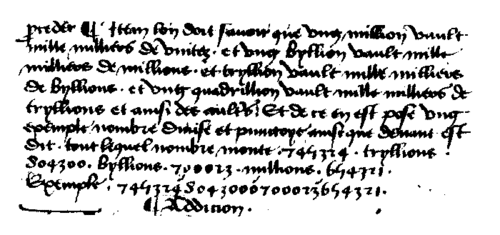- Nicolas Chuquet
-
Nicolas Chuquet Born 1445 or c. 1455
 France Paris
France ParisDied 1488 or c. 1500
 France Lyon
France LyonNationality French Education Bachelors degree in medicine Occupation Mathematician Nicolas Chuquet (1445, but some sources say c. 1455 – 1488, some sources say c. 1500) was a French mathematician whose great work, Triparty en la science des nombres [1] [2], was unpublished in his lifetime. Most of it, however, was copied without attribution by Estienne de La Roche in his 1520 textbook, l'Arismetique. In the 1870s, scholar Aristide Marre discovered Chuquet's manuscript and published it in 1880. The manuscript contained notes in de la Roche's handwriting.
Chuquet was born in Paris, France, and died in Lyon. His thinking was clearly far ahead of its time. He invented his own notation for algebraic concepts and exponentiation. He may have been the first mathematician to recognize zero and negative numbers as exponents.
His book shows a huge number divided into groups of six digits, and in a short passage he states that the groups can be called
- "million, the second mark byllion, the third mark tryllion, the fourth quadrillion, the fifth quyillion, the sixth sixlion, the seventh septyllion, the eighth ottyllion, the ninth nonyllion and so on with others as far as you wish to go.
Because of this, he is sometimes credited as the inventor of the modern names for large numbers. However, this is an oversimplification. The word million had been in use centuries prior to Chuquet.
In 1475, Jehan Adam recorded the words "bymillion" and "trimillion" (for 1012 and 1018) and it is believed that these words or similar ones were in general use at that time. Chuquet was, however, the original author of the earliest work using of a systematic, extended series of names ending in -illion or -yllion.
The system in which the names million, billion, trillion, etc. refer to powers of one million is sometimes referred to as the Chuquet system.
Around 1550, Jacques Peletier du Mans took a system based on powers of 106, and added the term "milliard" for 109. This system was then used in England and Germany and part of the rest of Europe. This system is sometimes referred to as the Chuquet-Peletier system.
Much later, in France and in the USA, a different short scale system became established where the term billion signifies 109. Last century, England and other English-speaking countries joined the USA and other countries in using the short scale system; whereas, France rejoined Germany, most of Europe, and much of the world in the Chuquet-Peletier, or long scale, system.
What is undeniable is that Chuquet was the author of the earliest system (published in the works Larismetique (1520) by Estienne de la Roche without attribution and Triparty en la science des nombres (written before 1488 but only published 1870) by Nicolas Chuquet) for names of large numbers by combining Latin-derived prefixes with the suffix -illion.
- "... Item lon doit savoir que ung million vault mille milliers de unitez, et ung byllion vault mille milliers de millions, et [ung] tryllion vault mille milliers de byllions, et ung quadrillion vault mille milliers de tryllions et ainsi des aultres : Et de ce en est pose ung exemple nombre divise et punctoye ainsi que devant est dit, tout lequel nombre monte 745324 tryllions 804300 byllions 700023 millions 654321. Exemple : 745324'8043000'700023'654321 ..."
- Item: one should know that a million is worth a thousand thousand units, and a byllion is worth a thousand thousand millions, and tryillion is worth a thousand thousand byllions, and a quadrillion is worth a thousand thousand tryllions, and so on for the others. And an example of this follows, a number divided up and punctuated as previously described, the whole number being seven hundred forty-five thousand three hundred and twenty-four tryllions, 804300 byllions 700023 millions 654321 ...
Short scale
comparisonChuquet Peletier Systematics Base 10 SI Prefix unit unit unit Million 0 10 0 (none) thousand thousand thousand Million 0.5 10 3 k (kilo) Million Million Million Million 1 10 6 M (mega) Billion thousand million Milliard Million 1.5 10 9 G (giga) Trillion Billion Billion Million 2 10 12 T (tera) Quadrillion thousand billion Billiard Million 2.5 10 15 P (peta) Quintillion Trillion Trillion Million 3 10 18 E (exa) Sextillion thousand trillion Trilliard Million 3.5 10 21 Z (zetta) Septillion Quadrillion Quadrillion Million 4 10 24 Y (yotta) See also
- English-language numerals
- Jacques Peletier du Mans
- List of numbers
- Long and short scales
- Names of large numbers
- Zillion
References
- O'Connor, John J.; Robertson, Edmund F., "Etymology of some common mathematical terms", MacTutor History of Mathematics archive, University of St Andrews, http://www-history.mcs.st-andrews.ac.uk/Miscellaneous/Mathematical_notation.html.
Categories:- 15th-century births
- 15th-century deaths
- French Roman Catholics
- People from Paris
- French mathematicians
- Numeration
- 15th-century mathematicians
- 15th-century French people
Wikimedia Foundation. 2010.

